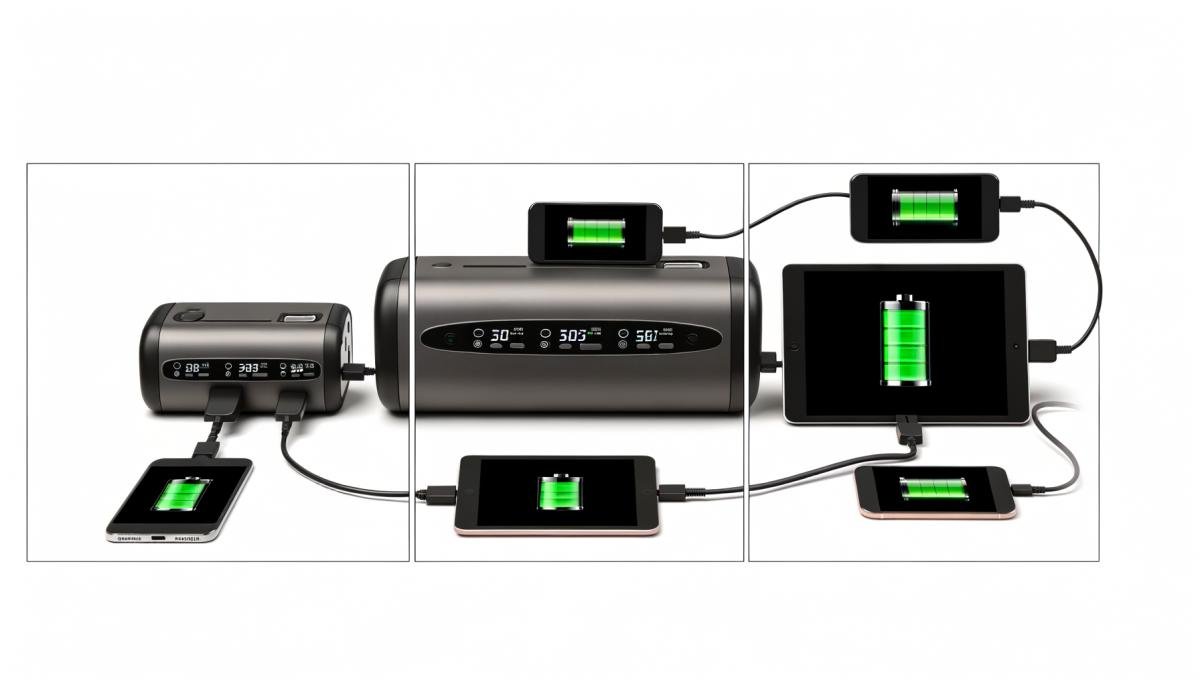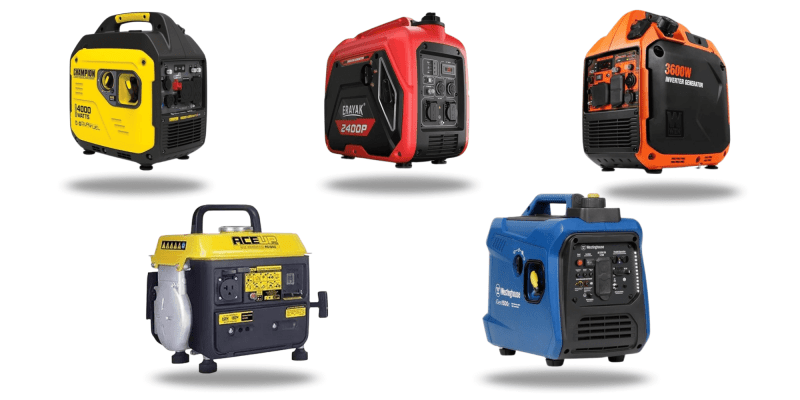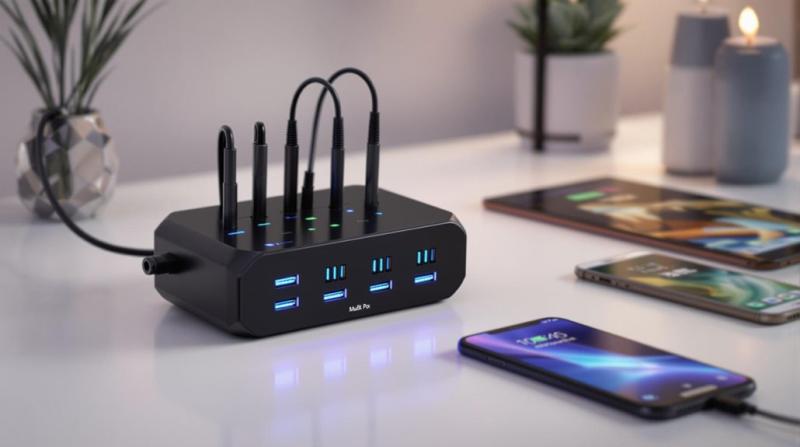When comparing battery capacity in portable power stations, it's all about looking at watt-hours (Wh) and amp-hours (Ah) to get a sense of the energy output. A higher Wh rating means longer runtimes for your devices. Ah helps you estimate the total charge delivered.
Now, let's talk batteries. Lithium-ion batteries are typically more efficient and have a longer lifespan compared to the old-school lead-acid ones.
But wait. Don't forget to check out the inverter output and the variety of outlets. You want to make sure they match your device needs, right?
For the cherry on top, consider the device wattage and the temperature ranges for ideal performance.
Understanding these factors will really help you land on the perfect power station for your needs. There's always more to learn, and these insights can definitely sharpen your decision-making.
Understanding Battery Capacity
Understanding battery capacity is super important if you want to get the most out of your portable power station. It directly affects how much energy you can store and use for your activities. Battery capacity is usually measured in watt-hours (Wh) or amp-hours (Ah). This tells you the total energy the battery can deliver over time. For example, if your power station is rated at 1000Wh, it can theoretically give you 100 watts for ten hours.
You really need to think about how much energy you use to figure out the right capacity for what you need. Start by calculating the total wattage of the devices you plan to power and then figure out how long you want them to run. This will help you understand the minimum battery capacity you need.
Also, don't forget about the efficiency of the inverter in the power station. Energy losses can happen when converting from DC to AC. A typical inverter might work at around 85-90% efficiency, so not all the stored energy reaches your devices.
Plus, if you frequently and deeply discharge the battery, it can reduce its lifespan and capacity over time. Going for a power station with a higher capacity than you need right now can give you a buffer for peak demands and help extend the overall lifespan of your investment.
Types of Battery Technologies
When you're checking out battery technologies for portable power stations, lithium-ion batteries really stand out. They pack a punch with high energy density and a long cycle life, which is why they're so popular.
On the flip side, lead-acid batteries have a few issues. They're less efficient and don't last as long, which can be a bummer for mobile applications.
But hey, there's some exciting stuff on the horizon! New battery options like solid-state and lithium-sulfur are coming into the picture. These technologies could shake things up by making batteries safer and better at using their capacity.
Lithium-Ion Advantages
Lithium-ion batteries are a game-changer when it comes to energy density and longevity, especially when you compare them to the old-school battery technologies.
They're super popular for portable power stations, and for good reason. You see, they typically reach up to 250 Wh/kg in energy density. That means they can pack a lot of power into a smaller space, making them lighter and less bulky. Perfect for when you need to move around.
On the flip side, those conventional lead-acid batteries? They usually max out around 50-100 Wh/kg, which means they're way bulkier and definitely not as easy to lug around.
And get this: the cycle life of lithium-ion batteries is often more than 2,000 charge cycles. Compare that to lead-acid batteries, which usually only manage about 500-800 cycles.
So, in the long run, you're replacing lithium-ion batteries way less frequently. That definitely saves you money. Plus, lithium-ion batteries have efficient charge and discharge rates, which means they can give you higher power output. That's super important if you're running multiple devices at the same time.
Lithium-ion batteries also come with some nifty safety features. We're talking overcharge protection and thermal management systems, which make them way more reliable than other types.
All these perks make lithium-ion batteries not just practical but also a really smart investment for portable power stations. They keep performing at their best and keep you happy for a long time.
Lead-Acid Drawbacks
Lead-acid batteries have been around forever, but let's be honest, they've got some pretty big drawbacks when it comes to energy density and cycle life.
The energy density of these batteries is usually somewhere between 30-50 Wh/kg. Compare that to lithium-ion batteries, which can hit 150-200 Wh/kg, and you start to see the problem. Basically, you'd need a much bigger and heavier lead-acid battery to store the same amount of energy as a lithium-ion one. Not exactly ideal if you're looking for something portable.
And then there's the cycle life. Lead-acid batteries give you about 500-800 charge-discharge cycles. Lithium-ion batteries? They can go for 1,500-3,000 cycles. So, you'll be replacing lead-acid batteries more often, which isn't great for your wallet or the environment.
Let's not forget the maintenance. Lead-acid batteries need regular checks and water top-ups to keep them running smoothly and to prevent sulfation. That's a lot more hands-on work compared to other types of batteries.
Emerging Battery Options
Hey, as the demand for efficient and portable power keeps growing, there are some cool new battery technologies that are set to change the game.
Take lithium-sulfur (Li-S) batteries, for example. These bad boys could seriously up the energy density compared to the usual lithium-ion batteries. We're talking potentially up to 600 Wh/kg versus the 150-250 Wh/kg you get with lithium-ion. Imagine packing more energy into a lighter setup—that's a huge win for portable power stations!
Then there are solid-state batteries. These use a solid electrolyte instead of the liquid kind, which means they're safer and more efficient. They can charge faster and last longer, making them perfect for stuff you use all the time.
If you're thinking about the environment, sodium-ion batteries are making waves too. They use sodium instead of lithium, which is way more common. They're still in the works, but they could be a super sustainable option for big energy storage.
Don't forget about graphene batteries. These things promise super-fast charging times and crazy good longevity.
All these new technologies give us a sneak peek at a future where portable power stations aren't just better—they're way better. We're talking higher capacity, faster charging, and top-notch safety.
Measuring Battery Capacity
To effectively measure battery capacity, you've got to get familiar with a couple of key metrics.
First, there's ampere-hours (Ah), which basically tells you the total charge a battery can deliver over a specific period.
Then, there's the watt-hour calculation method. Watt-hours give you a clearer picture of the energy capacity, especially when you consider the voltage.
Once you get a handle on these concepts, you'll be able to compare and evaluate the performance of different portable power stations much more accurately.
Understanding Ampere-Hours (Ah)
Understanding ampere-hours (Ah) is super important if you want to get a clear idea of the energy capacity of portable power stations. This directly affects how long your device can keep your equipment running.
So, what exactly is Ah? Well, it measures the total amount of electric charge a battery can deliver over one hour at a constant current. The bigger the Ah rating, the more energy the battery can store, which means your devices will run longer.
When you're checking out power stations, it's really important to think about how Ah relates to your specific needs. Like, say you want to run a device that draws 5 amps, and your power station has a capacity of 20 Ah. You can expect it to run for about four hours before you need to recharge. This connection between Ah, how much current your device draws, and the runtime is crucial for making sure you pick a power station that fits your needs.
Plus, keep in mind that different devices need different amounts of power. So, knowing the Ah rating of your portable power station can really help you make a better choice. It lets you match it up with what you plan to use it for.
Definitely focus on this metric to get the best performance and make sure you're happy with your pick.
Watt-Hour Calculation Method
Measuring battery capacity often involves calculating watt-hours (Wh), which basically gives you a better idea of how much energy a portable power station can store and deliver. The calculation is simple: just multiply the battery's voltage (V) by its ampere-hours (Ah). So, the formula looks like this: Wh = V × Ah.
Let's say you have a power station with a 12V battery, and it stores 100Ah. You're looking at a capacity of 1,200Wh. This number tells you how much energy the battery can provide over time.
When you're checking out portable power stations, watt-hours are super important. They help you compare different models effectively. A unit with higher Wh can keep your devices running longer or power energy-hungry appliances like refrigerators or power tools.
But wait, there's more! You also need to consider the efficiency of the inverter, because some energy is lost when converting from DC to AC current. Factoring in the inverter's efficiency gives you a more realistic idea of how many watt-hours you can actually use.
Knowing this not only helps you make smarter buying decisions but also ensures you get the most out of your power station when you need it.
Factors Affecting Performance
Alright, so let's dive into what makes portable power stations tick. We're talking about things like battery chemistry, capacity, temperature, and load management. Each of these plays a huge role in how efficient and long-lasting your power station will be.
First up, battery chemistry. The kind of battery you're using really matters. Lithium-ion batteries are pretty popular because they can store more energy and last longer than old-school lead-acid batteries. So, if you want more bang for your buck, lithium-ion is the way to go.
Now, let's talk about capacity. This is measured in watt-hours (Wh), which tells you how much total energy can be stored. But here's the catch: just because a power station has a high capacity doesn't mean it'll last longer. It all depends on what you're plugging into it. High-wattage devices will drain it faster than low-wattage ones. So, knowing what your devices need is super important.
Temperature is another biggie. These power stations usually work best in a temperature sweet spot, generally between 32°F to 104°F (0°C to 40°C). Go outside of that range, and you'll see a drop in efficiency and battery lifespan. Cold can mess with the chemical reactions in the battery, making it less effective. And if it gets too hot, well, you risk overheating and damaging the thing.
Alright, last but not least, load management strategies can really make a difference. Things like peak shaving or smart energy distribution can help you get the most out of your power station. Basically, the better you manage your load, the longer your power station will run. So, keep an eye on these factors, and you'll get way better performance and reliability out of your portable power setup.
Comparing Popular Models
When you're comparing popular portable power station models, it's super important to check out things like watt-hour capacity, inverter output, and the number of outlets. This way, you can figure out which one matches your energy needs best.
So, let's say you're looking at a model with a 500Wh capacity versus one with 1000Wh. The 500Wh model might do just fine for your smaller gadgets, like phones and laptops, for a few hours. But if you need to power something bigger, like a mini fridge or a microwave, the 1000Wh model is definitely the way to go.
Now, let's talk about inverter output. If you get a model with a pure sine wave inverter at 600W, it's perfect for running sensitive electronics safely. Think medical devices, for instance. On the other hand, a modified sine wave inverter could potentially cause some issues with those kinds of devices.
Also, keep an eye out for intermittent surge ratings. Some gadgets need a quick burst of power to get started, and not all models can handle that well.
And don't forget about the number of available outlets. A solid model should offer a mix of AC outlets, USB ports, and DC outputs. This way, you can plug in multiple devices at once.
Picture this: you're camping or dealing with a power outage. Having a variety of outlets would make everything so much easier and more convenient.
Choosing the Right Power Station
Choosing the right portable power station really comes down to figuring out what you need it for, how you're going to use it, and what devices you want to keep charged up.
First things first, check out how much power your essential gadgets need. Like, your smartphone usually needs around 5-10 watts, while a laptop could gobble up 65-100 watts. Make a list of all your devices and add up their wattage so you know the minimum output your power station should have.
Now, let's talk capacity, which is measured in watt-hours (Wh). This number tells you how long the power station can keep your devices running. Say your total wattage is 100 watts and you want five hours of juice—you'll need at least a 500Wh power station. But hey, it's always a good idea to get one with a bit more capacity, because running devices at max output all the time can really wear out the battery.
Oh, and don't forget about the output ports. Make sure the power station has a good mix of AC, USB, and DC ports to handle all your different devices. If you're planning to charge a bunch of stuff at once, go for a model that can handle higher output to keep everything running smoothly.



